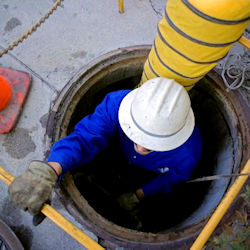Confined Space Safety Basics
Definitions
In order to fully understand the information offered in this course, you must first understand the OSHA definitions.
Enclosed Spaces
OSHA does not consider all spaces as confined spaces: these spaces are defined as enclosed spaces. For example, a room with a standard door and adequate ventilation would not be considered a confined space.
Confined Spaces
OSHA defines a confined space as an enclosed space that meets all of the following 3 criteria:
- It is large enough for an employee to enter and perform work; Example: A storage tank or a manhole.
- It has limited or restricted means for entry or exit; Example: A small crawl space with a narrow opening, or a tank with a small access hatch.
- It is not designed for continuous occupancy. Example: An underground utility vault or a wastewater treatment tank.
Non-Permit-Required Confined Spaces (NPRCS)
A non-permit-required confined space is a confined space that does not pose significant hazards to workers' safety and health, and therefore does not require a permit for entry.
These spaces have characteristics such as adequate ventilation, natural or mechanical, that maintain acceptable atmospheric conditions, and have limited or no potential for containing substances that could harm the workers.
Below and throughout the course, you can read the OSHA 1910.146 rules. Just click on the links.
Confined space means a space that:
- Is large enough and so configured that an employee can bodily enter and perform assigned work; and
- Has limited or restricted means for entry or exit (for example, tanks, vessels, silos, storage bins, hoppers, vaults, and pits are spaces that may have limited means of entry.); and
- Is not designed for continuous employee occupancy.
Non-permit confined space means a confined space that does not contain or, with respect to atmospheric hazards, have the potential to contain any hazard capable of causing death or serious physical harm.
Knowledge Check Choose the best answer for the question.
1-1. A confined space must have limited means of entry (access) and exit (egress). How is "limited means of entry" defined?
You forgot to answer the question!

